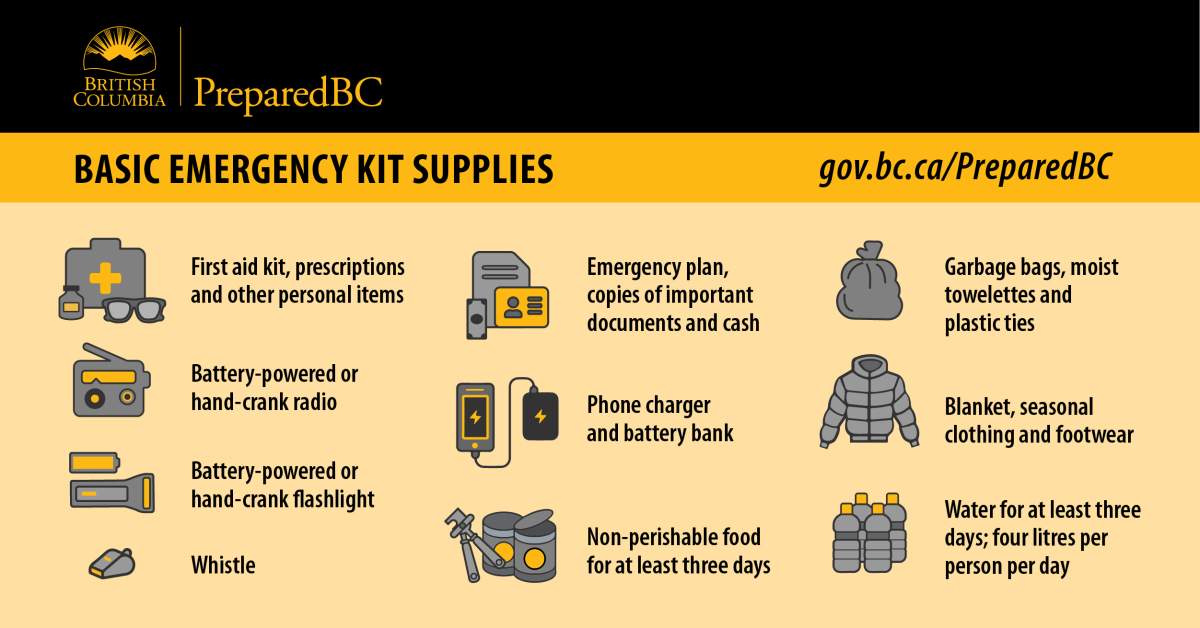As fire swept into Lytton, B.C., many of the community’s residents were given as little as 15 minutes to grab their essentials and flee to safety.

The destructive fire was a powerful reminder of how quickly a disaster can unfold, and how important it is to be prepared.
With climate change expected to deliver more frequent, more intense and longer wildfire seasons — and with 2021 shaping up to potentially be among the worst on record — here’s how you can prepare in advance.
Prepare ahead of time
“Conditions are tinder dry out there. So even if you’re not under an evacuation alert, now’s a great time to get prepared for the possibility of a wildfire,” Emergency Management BC information officer Ryan Turcot said.
Turcot recommends families create an emergency plan ahead of time, one that lays out how their household will respond to a disaster with key information like who will pick up children from school, pet information, contact information and more.
Residents are also encouraged to prepare an emergency kit to keep in an easy-to-access place, as well as a smaller, pared-down “go bag” for sudden emergencies, and which could be stored in a vehicle or at work.

The kit should contain food, water, a phone charger, a battery or crank-powered radio and flashlight, batteries, a first-aid kit, cash, your emergency plan, copies of key documents and more. You can see a detailed list of recommended items here.
It is also useful to familiarize yourself with your regional district or municipality’s emergency communication methods. Look up and bookmark the website and/or Facebook page for your region’s emergency operations centre, where evacuation alerts and orders will be posted.
“It’s very crucial that you know who your Indigenous or local governments are and how they’re going to communicate information out during an evacuation order,” Turcot said.
“Follow them online, learn their contact numbers, follow them on social media and be prepared to hear from them there in the event of an evacuation order — those are going to be the officials that are actually issuing it and giving you the details that you need.”
In an evacuation alert
Municipalities or regional districts will issue an evacuation alert when a community may be at risk.
In this situation, you should be ready to leave at a moment’s notice.

Get breaking National news
This is the time to locate all members of your household and designate a meeting place outside of the danger area in case you are separated.

Ensure your vehicle is fueled and everyone in the household has transportation. Prepare your pets and/or livestock for safe travel.
“This is really the time that you want to start making sure you have your grab and go bags prepared, packed and ready to go,” Turcot said.
It’s also the time to ensure you have key documents like insurance, mortgage and credit information, along with birth certificates and government-issued identification.
Emergency Management BC also recommends you pack the following during an evacuation alert:
- A cellular phone
- Several days’ clothing
- Medicine/prescriptions, glasses
- Comfort items for children, like a favourite toy or colouring books to help keep them busy
- Leashes, carriers and food for pets
- Irreplaceable photos and mementoes
Officials also advise people to check on their family, friends or neighbours who might need help because of mobility or other issues.
Take a moment to familiarize yourself with the emergency situation in your region, and continue to follow local media.
EmergencyInfoBC has an interactive map with a list of current emergencies, along with evacuation alerts and orders.
Know the road conditions. Motorists are advised to monitor the DriveBC website and Twitter account for the latest on closures and detours.
You can also find trusted information through the BC Wildfire Service’s website and Twitter account, and EmergencyInfoBC’s website and Twitter account.
In an evacuation order
Properties are placed under an evacuation order when their residents are at immediate risk.
“If you’re issued an evacuation order, you need to leave immediately — and that’s for your safety and the safety of first responders,”
Turcot said.
“We know that when you are issued an evacuation order, it can be stressful. It can be a very stressful situation, but it’s not worth the risk to stay behind.
When an alert is issued, load the items, people and gather pets into your vehicle and leave immediately. Failing to do so can put you and others in danger, according to Emergency Management BC (EMBC).
Before you go, close all doors and windows; latch, but do not lock, gates. If you have time and it’s safe, shut off water and electricity in the home.
Evacuees should wear sturdy shoes, long-sleeved shirts and pants to protect against hazards, and follow evacuation routes specified by emergency officials. Avoid shortcuts, which could take you into danger.

People with pets will not be permitted in emergency shelters. Go to a friend or relative’s home or find a pet-friendly hotel.
If you are going to an evacuation centre, register when you arrive so people can contact you and you can be reunited with friends or family.
Evacuees are also urged to register online.
At this point, EMBC also recommends you contact an out-of-area emergency contact to tell them you’re OK, how to get in touch with you and to let them know about any missing or separated family members.
Wait for the evacuation order to be rescinded.
When the situation is deemed safe, officials will give the all-clear to return home, but you should continue to monitor for potential new evacuation alerts or orders.









Comments